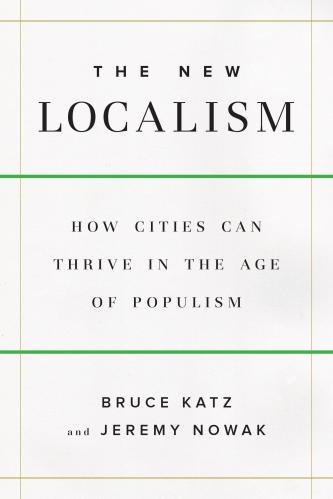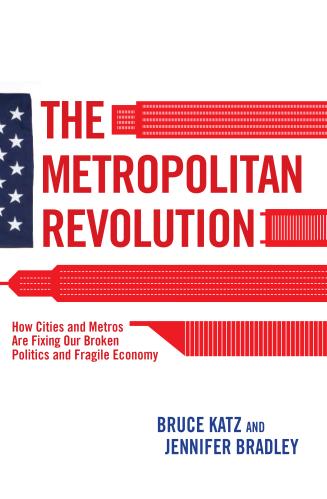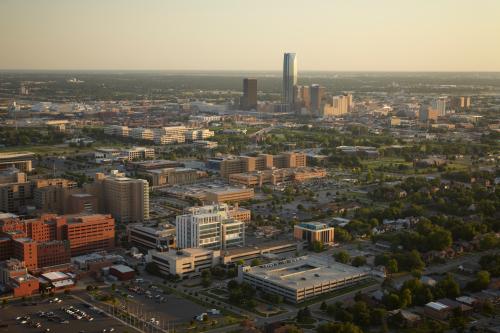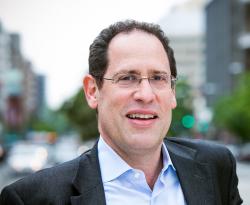Cities rise above international competitors not just through their ability to innovate within single industries—say, auto, steel or energy—but also by identifying new points of convergence across them. Pittsburgh’s renewal, for example, has been spurred by its research in new technologies—robotics, artificial intelligence, big data analytics—that cut across multiple sectors and clusters ranging from transportation to health care.
Last week, Brookings and the Project for Public Spaces released “Positioned for Growth: Advancing the Oklahoma City Innovation District.” The report examined the city’s Medical District, a traditional academic medical center that is now positioned to cross-pollinate its long-term strength in life science research into industries like energy and aerospace that drive employment throughout the broader Oklahoma City economy.
![Google Earth map of Oklahoma City with the innovation district and its key assets overlaid [image credit: Google Earth and Brookings]](https://i0.wp.com/www.brookings.edu/wp-content/uploads/2017/04/okc_innovation_district_map.png?w=768&crop=0%2C0px%2C100%2C9999px&ssl=1)
Like most academic medical centers, the Oklahoma Health Center was established in the middle of the last century with the exclusive mission of health education, research, and care. To this end, state zoning greatly restricted land use in the area, prohibiting mixed-use and residential development and encouraging suburban development patterns. For decades the district kept to its health mission, based on its core institutional assets—the Oklahoma Health Center Foundation, the Presbyterian Health Foundation and the Oklahoma Medical Research Foundation (OMRF)—that conducted quality health research with commercial effects. And it did its job well: an area that only occupies .002 percent of the land mass of Oklahoma has garnered 77 percent of the NIH funding for the entire state.
![Infographic showing that Oklahoma City, an area that only occupies .002 percent of the land mass of Oklahoma has garnered 77 percent of the NIH funding for the entire state. [image designed by MTWTF design]](https://i0.wp.com/www.brookings.edu/wp-content/uploads/2017/04/okc_nih_infographic.jpg?w=768&crop=0%2C0px%2C100%2C9999px&ssl=1)
Then something unexpected happened. In 2013, General Electric decided to locate a global research center focusing on oil and gas exploration in Oklahoma City. The center is one of ten globally and the only one to be dedicated to one industry. This wasn’t surprising given the presence of major companies like Devon and Chesapeake Energy. What was surprising and fortuitous was GE’s decision to build its new facility in the Medical District.
From a distance, energy and health care do not appear to have anything to do with each other. But, upon closer examination, these super-sectors depend upon several common technologies and techniques. Imaging. Sensors. Robotics. Big Data Analytics.
For this reason, the main recommendation of our report was that Oklahoma City establish the Oklahoma Center for Energy and Health Collaboration: “The goal of the center would be to create a powerful link between applied research and regional economic development that, over the next decade, positions Oklahoma City as the premier global destination for innovation at the intersection between energy and health care.”
In true Oklahoman style, local leaders did not wait for the ink to dry on the report. Just last month a symposium on imaging was held at GE’s new research facility. The convening exceeded all expectations. As Steve Prescott of OMRF recounted in The Oklahoman, scientists from the health, energy and aerospace sectors “do everything from studying the metastasis of tumor cells to analyzing cracks in airplane wings to making drilling decisions.” And in all these areas, it became clear that the seemingly disjointed sectors are, in fact, linked by imaging technology. The city discovered hidden assets in their own backyard: who knew that the FAA (which has a major presence in the Oklahoma City region) has significant medical research capabilities. Now multiple stakeholders have agreed to hold a symposium on big data and are planning large and small gatherings. Collaboration is infectious once it gets started.
One obstacle to that collaboration stems from the district’s physical development patterns. My colleagues at PPS routinely advise local residents to just get started with place making and activate public spaces with strategies that are “lighter, quicker cheaper”—programming activities like food events, outdoor performances or health fairs. Leaders in Oklahoma City are smartly applying this modus operandi to the innovation space. They are getting out of their buildings, literally and figuratively, and finding connections between institutions that lie in close proximity but have been kept separate and distinct for decades. They are staking new technological territory that naturally emerges from their cluster strengths and sectoral concentration.
As my colleague, Scott Andes, describes it, “Once actors see the tangible value of collaboration, building the formal structures that enable joint investment becomes much easier. These symposia are the first step in identifying points of mutually beneficial research occurring in the region that can be meaningfully built upon to develop new products.”
Where will Oklahoma City’s activities lead? Perhaps universities across Oklahoma might want to establish a presence in the innovation district, to explore new synergies? Perhaps the local symposia will grow to state and then global symposia? Perhaps other researchers and companies that play in energy and health care—and sophisticated sectors like agriculture and aerospace—will find a reason to be in this livable city?
In today’s political maelstrom, where cut backs to higher education are being executed and reductions in basic science funding are being contemplated, the push towards economic convergence is a necessary way to invent products, grow jobs, expand companies, and enhance fiscal stability. As Steve Prescott aptly put it, referring to the district’s current direction: “This is what an innovation district looks like.”








Commentary
Converging possibilities: Oklahoma City’s innovation district
April 25, 2017